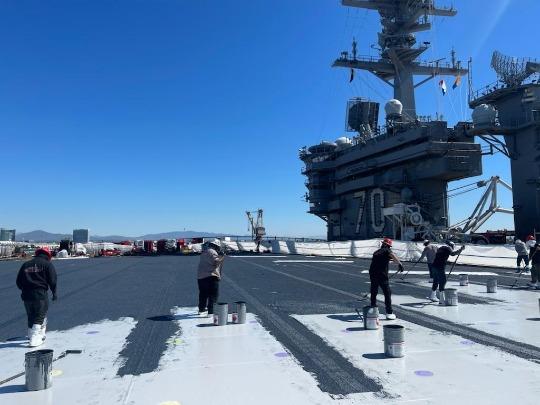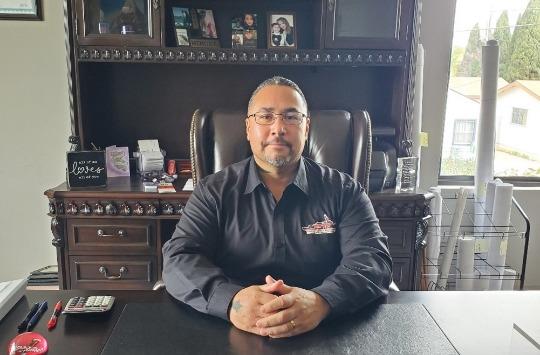Strap in, because it’s time to gain some traction on an often overlooked, but vitally important topic: Non-skid surfaces on Navy ships.
You might be scratching your head, thinking, “Really? An entire guide on this?” But it’s precisely this underestimation that makes it such a hidden gem of a topic. Non-skid surfaces are indispensable, and especially in the military, where the safety and performance of Navy personnel can hinge on them.
In the frenzied environment of a U.S. Navy ship, everything is in perpetual motion. The deck can be slick from the sun’s relentless heat or the unpredictable sea spray, making each step a potential hazard.
This is where non-skid surfaces play their starring role. They are the unsung heroes, providing the grip and assurance for personnel to move swiftly and confidently around.
So, let’s dive in, shall we? Let’s peel back the layers on this fascinating world of non-skid surfaces, where every coating counts and time is always of the essence. Here’s your front-row seat to the high-stakes, high-speed world of naval safety.
Initial Considerations
First things first, let’s talk about the types of non-skid surfaces. There are several types, but the most common ones used on Navy ships are type one, type four, type five, type six, type seven, and type eight.
Each type has its own unique properties and uses. For instance, type one is used throughout the ship, with the exception of aircraft carrier landing areas. Meanwhile, type four is used on littoral combat ship (LCS) types. Type five is similar to type one, but it has a longer life expectancy. Types six and seven are fast-curing, non-skid, while type seven is a temporary fix. Type eight is designed for applications in colder regions.
Now, let’s move on to the importance of primers and compounds. Primers play a crucial role in the non-skid coating system. They serve as the barrier coat between the non-skid and the substrate, helping to prevent corrosion. The most common primers are polyamide primers, which are designed to withstand the beating that non-skid surfaces take.

Application Methods
When it comes to the application of non-skid surfaces, there are several methods. The most common method involves using a phenolic roller, which peaks up the aggregate and the epoxy resin in the non-skid, creating an anti-slip surface. Other methods include thermal spray non-skid, which is a complex system used by robotics; and peel and stick non-skid, which is a simple method that involves laying an adhesive-backed non-skid on the deck.
Despite the best efforts, failures can occur with non-skid surfaces. However, unlike other coatings, non-skid surfaces cannot be repaired by feathering the edges and applying a new coating. The best way to repair a non-skid surface is by squaring off the area, accomplishing the surface prep, and then applying a new coating.
Non-skid systems are not like most coatings. They are a unique beast, and they require a specific approach and understanding.
Many other types of marine coatings, designed for assets ranging from tanks to underwater hulls, have their own challenges. But one thing that stands out about non-skid is its recoat window times. It’s a race against the clock, and a test of skills and efficiency.
When applying non-skid, contractors should be aiming for a tight seal, or a perfect overlap to ensure the vessel’s safety and functionality. This is a process that requires a keen eye and a steady hand. First is applying the primer, followed by the non-skid. This ensures the peak is achieved, the valley goes forward to half, and it overlaps by maybe a quarter-inch (0.6 cm).
It is a dance of precision and accuracy, a testament to a contractor’s skills and expertise.
Other Considerations
But this process is not just about the application. It’s also about the removal. Contractors are dealing with a coating that is approximately three-eighths of an inch (1.0 cm) thick, making for a formidable challenge to remove. A contractor could spend all day nozzle blasting and only cover a small area.
Instead, they could opt for centrifugal steel shot blasting or ultra-high-pressure water jetting, which are more efficient methods that allow users to cover more ground.
There’s also the issue of shelf life. Non-skid has a one-year shelf life, and this ticking clock adds another layer of complexity to the work. Orders are often made months in advance, and sometimes without a job lined up. It’s a gamble, but it’s a risk a contractor must take in order to ensure materials are available when needed.

Research and Integrity
In navigating this world of non-skid systems, remember the importance of research and integrity. Review the standards, understand the products, and always uphold the highest level of professionalism. After all, lives are at stake. Non-skid systems are not just about coatings. They’re also about safety, efficiency, and the smooth operation of naval vessels.
While not the glitziest subject matter, non-skid surfaces are paramount to the safety of personnel aboard naval ships. Grasping the variety of non-skid surfaces, as well as the significance of primers, application techniques, and the knack for repairing failures, is critical for anyone involved in this sector.
So, next time your foot lands on a non-skid surface, spare a thought for the science and diligence that went into its creation. It’s a realm underscored by precision, speed, and safety, and a sphere where a contractor’s skills and expertise have the potential to create real impact.
Gear up, pick up the right tools with a steady hand, and plunge right in.
Editor’s note: Titled Non-Skids: A Complex Coating System, the complete AMPP webcast on this topic can be viewed here.